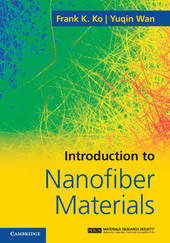
|
Introduction to Nanofiber Materials
Hardback
Main Details
| Title |
Introduction to Nanofiber Materials
|
| Authors and Contributors |
By (author) Frank K. Ko
|
|
By (author) Yuqin Wan
|
| Physical Properties |
| Format:Hardback | | Pages:282 | | Dimensions(mm): Height 253,Width 177 |
|
| Category/Genre | Nanotechnology
Materials science |
|---|
| ISBN/Barcode |
9780521879835
|
| Classifications | Dewey:620.115 |
|---|
| Audience | | Professional & Vocational | |
|---|
| Illustrations |
20 Tables, black and white; 61 Halftones, unspecified; 155 Line drawings, unspecified
|
|
Publishing Details |
| Publisher |
Cambridge University Press
|
| Imprint |
Cambridge University Press
|
| Publication Date |
31 July 2014 |
| Publication Country |
United Kingdom
|
Description
Presenting the latest coverage of the fundamentals and applications of nanofibrous materials and their structures for graduate students and researchers, this book bridges the communication gap between fiber technologists and materials scientists and engineers. Featuring intensive coverage of electroactive, bioactive and structural nanofibers, it provides a comprehensive collection of processing conditions for electrospinning and includes recent advances in nanoparticle-/nanotube-based nanofibers. The book also covers mechanical properties of fibers and fibrous assemblies, as well as characterization methods.
Author Biography
Frank K. Ko is Canada Research Chair Professor in Advanced Fibrous Materials and Director of the Advanced Materials and Process Engineering Laboratory, University of British Columbia. Yuqin Wan is Research Associate in Advanced Fibrous Materials, Advanced Materials and Process Engineering Laboratory, University of British Columbia, Canada and Associate Professor in the School of Textiles and Clothing, Jiangnan University, China.
Reviews'An in-depth explanation of the basic properties of polymers helps the reader to refresh knowledge acquired during university courses, and is a very good introduction to further content, especially various methods of fiber formation, with understandable and clear schematics which are essential to fully understand nanofiber formation and their advantages and limits ... The principles of every method described in the book are also explained in a very approachable way. Characterization methods are presented in accordance with recent research, which shows the reader how to apply those methods in the laboratory and how to interpret the results ... I would recommend this book for students and researchers of various fields interested in the electrospinning process and nanotechnology research. This publication is valuable and comprehensive and will guide the reader through all steps of the creation, application and characterization of nanofiber materials.' Seeram Ramakrishnaa, Acta Crystallographica Section B
|